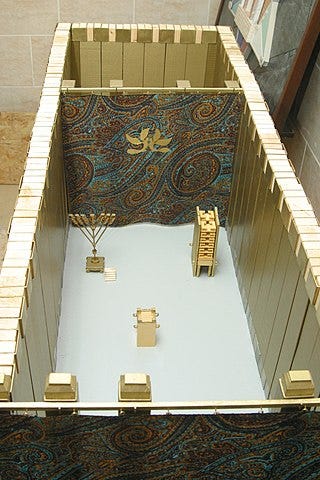Measures and Half-Measures:
Torah in Memory of Matthew Eisenfeld and Sara Duker on their Twenty-Seventh Yahrtzeit
It has somehow been twenty-seven years since our dear friends, classmates and study partners Matt Eisenfeld and Sara Duker were among those murdered in a terrorist bus bombing in Jerusalem. Every year as the yahrzeit arrives with the traditionally joyous month of Adar, Matt and Sara and their legacy embeds itself into the Torah of the day.
This year, as it often is, the Torah portion is Terumah, the description of the building of the Holy Dwelling, the Mobile Sanctuary called the MIshkan, upon which G*d’s presence is to rest and the implements of sacred ritual are to be kept. The central words that mark this project are found in Exodus 25:8 v’asu li mikdash v’shokhanti b’tocham, Let them build Me a Holy Place that I may dwell among them. The building of the sanctuary however is not presented only in such broad terms but in meticulous detail - what materials, how they are to be joined and the exact dimensions of the objects.
This last set of details, the dimensions, provides the basis for an unexpected and beautiful teaching brought by the Kli Yakar, a 16th century commentary written by Shlomo Ephraim Lunschitz. There are three holy vessels that are described as being wreathed with a gold crown each corresponding to one of the crowns representing the virtues upon which the world rests. The crown of Torah found on the ark, the crown of priesthood found on the incense altar and the crown of sovereign responsibility found on the table which contained the bread that would ultimately be distributed to those in need.
The Kli Yakar points out an interesting feature of these holy vessels: the measurements of the ark are all in halves: two and one half cubits in length and one and one half cubits in width and height. The measurements of the altar are all wholes - five in length, five in width and three in height. Finally, the table had both kinds of measurements, namely two, one, and one and a half cubits.
From these seemingly arbitrary details can be learned profound lessons about the vital practices of Torah study, prayer and acts of responsibility and kindness.
The Ark is made of half measurements because Torah is never complete, either in material to learn or meaning to comprehend. My perspective, no matter how well it is supported and argued, must be laid side by side by another. The crown of Torah is only acquired with such awareness and the humility that comes with it.
The Altar on the other hand is made of whole measurements because prayer requires a different way of seeing. Despite our desperate incompleteness before our Creator, our prayers stretch out in full and reveal the world as it can be unhindered by the shortcomings and brokenness. Prayer reflects faith that nothing is impossible.
And then we turn to the table and its bread, from which those in need are to be fed. . Acts of loving kindness and just treatment can only happen when the work is real and the view is unobstructed by faith and undeterred by despair. The Table reminds us to commit to recognizing those which are broken and striving to make them whole.
The Kli Yakar may have well been writing about Matt and Sara who delved deep into the meaning of the rituals and practices that structured their lives and inspired who they were in the world. What they learned and taught from our Torah came from a place of inquiry and often uncertainty, learning from each person and knowing that the whole story could be sought but not found. Their prayer life was rich and layered, never satisfied with just repeating words and yet projecting the fullness of commitment, the all-in. And, of course, they were baalei chesed, masters of generosity in giving time, creativity and resources toward real projects of mending and tending to those in need and the challenges that underlie inequities and broken systems.
The Torah portion’s instructions as to how to build this place and it’s implements lie before us now even though it has been millennia since they were followed and the place for G*d’s dwelling was made. Unlike the vessels in the sanctuary, represented in the perfection of ideal descriptions, Matt and Sara had to hold and sometimes wear the crowns of Torah, worship and responsibility for others in the midst of imperfect lives and a very troubled world. What they accomplished is remarkable and what they left in the hearts of those of us to whom they are so dear is immense. Perhaps, they are easier to find in these descriptions because they too have become transmuted to the details of memories. If so, I know every single one of us would trade the perfect edges of their legacy to have them with us in all of their unevenness. In measures and half-measures and things that can’t be measured at all. For now, let us continue to build a place of sacred memory that they can continue to dwell among us.




